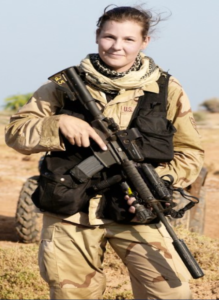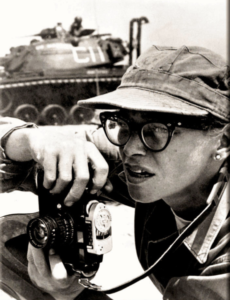STORIES FROM THE REGISTER


SSgt Stacy L. Pearsall, USAF Ret., Air Force 1998-2008 – John Levitow Award Winner; DOD Military Photographer of the Year 2003 & 2007; Joint Service Member of the Year 1999 & 2000; NCO of the Year 2003.
Stacy Pearsall began her Air Force years in the photo lab at Offutt AFB, Nebraska. One day a man wearing a flight suit came in and slapped down some film and said he needed it developed fast, at that moment Stacy decided she wanted to be what he was, which was an aerial combat photojournalist. While on active duty, she won the Military Photographer of the Year award twice. She is one of only two women to win the DOD-wide competition and the only woman to earn it twice. As a combat photographer, SSgt Pearsall served three tours in Iraq. She was recognized for her heroic actions under fire twice and earned the Bronze Star and the Air Force Commendation Medal with Valor. In 2008, Stacy was medically retired as a result of her combat injuries but never lost her love of photography. Incorporating it into recovery and therapy, she founded the Veterans Portrait Project, traveling across the US taking photos of the nation’s veterans and gifting their portraits to them.
Her new mission in life is to share the unique stories of military veterans and honor their service in a unique, creative way. Stacey’s portfolio includes more than 8500 portraits. In addition, she has authored two books, “Shooter: Combat from Behind the Camera” and “A Photojournalist’s Field Guide: In the Trenches with Stacy Pearsall.” Stacy can also be seen on television through her PBS series, “After Action,” which seeks to demystify the military experience, provide a platform for dialogue among family members and preserve military stories, many of which, to date, have been left untold.

Maj Megan M. McClung, Marine Corps 1995-2004; Marine Corps Reserve 2004-2005; Marine Corps 2005-2006 – Maj McClung graduated from the Naval Academy in 1995, receiving a commission in the U.S. Marine Corps. She served as a Public Affairs Officer in a variety of locations, including Marine Corps Air Station Cherry Point, NC, and left Active Duty in 2004, joining the Marine Corps Reserve and deploying that same year to Iraq as a civilian public affairs officer with the defense contractor Kellogg, Brown and Root. Possessing a strong desire to return to the Marine Corps to tell the story of the courageous American men and women in uniform and the job they were doing, she returned to active duty in 2005. She truly believed in the mission as well as the Iraqi people’s right to their freedom. She deployed again to Iraq in January 2006 as a Public Affairs Officer with the 1st Marine Expeditionary Force Headquarters Group, Camp Pendleton, CA, where she managed the media embed program and developed public affairs plans for operations.
An avid runner and triathlete, she helped organize and also ran the 2006 Marine Corps Marathon (Forward) in Iraq. She died while escorting journalists in Ramadi when a roadside bomb exploded near her vehicle. The fourth woman Marine to die in Iraq and the highest ranking woman, her name is the first to go on a marble tablet at the Academy honoring graduates killed in action.

Dickey Louise Chapelle – Dickey Chapelle was among the first female war correspondents and the first American female war correspondent “killed in action.” She was killed by grenade and mortar shrapnel on Nov. 14, 1965, while on patrol with the U.S. Marines near the Song Tra Bong River in Vietnam. The next day General Wallace M. Greene Jr., Commandant of the Marine Corps, wrote of her death, “All U.S. Marines the world over mourned the death of Dickey Chapelle who died of wounds received while covering combat operations by Marines in South Vietnam on November 4, 1965. She was not only a skilled, dedicated newspaperwoman, but she was an exemplary patriot whose great love for her country was an inspiration to all who knew her. It has been said by her media colleagues that she died with the men she loved. It must also be said that affection, admiration, and respect was mutual. She was one of us, and we will miss her.”
The Marines erected a memorial to her in Vietnam and the Marine Corps League annually presents the “Dickey Chapelle Award” in her honor to civilians whose work supports the U.S. Marines. During her more than 20-year career as war correspondent, Chapelle covered conflicts across the world for such publications as Reader’s Digest, Life and National Geographic. She covered U.S. troops in Panama, Guam, Iwo Jima and Okinawa during World War II; conflicts in Algeria, Hungary, Cuba, Lebanon, and the Dominican Republic after WWII, as well as training patrols and combat with the U.S. Marines and South Vietnamese troops in Vietnam. While covering the Hungarian uprising in 1956, she was taken prisoner and held for two months in a Hungarian prison where she was set to be executed until the U.S. intervened. A collection of her war photography is housed at the Wisconsin Historical Society in Madison, Wis., with some photographs published in a photo gallery book of her work, “Dickey Chapelle Under Fire” by John Garofolo.
